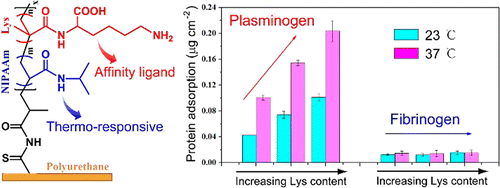Thermoresponsive Copolymer Decorated Surface Enables Controlling the Adsorption of a Target Protein in Plasma
Weikang Yang
The Key Lab of Health Chemistry and Molecular Diagnosis of Suzhou, College of Chemistry, Chemical Engineering and Materials Science, Soochow University, 199 Ren’ai Road, Suzhou 215123, Jiangsu, People’s Republic of China
ACS Appl. Mater. Interfaces 2014, 6, 10146–10152
The control of protein/surface interactions by external stimuli is often required in bioapplications such as bioseparation and biosensors. Although regulation of protein adsorption has been achieved on the surfaces modified with stimuli-responsive polymers, controlled protein adsorption is still challenging for a target protein in a multiprotein system. The present study developed a concept of surface design for the controlled adsorption of a specific protein from plasma by combining a thermoresponsive polymer with an affinity ligand on the surface. In this regard, a polyurethane (PU) surface was modified with the copolymer of N-isopropylacrylamide (NIPAAm) and a ε-lysine-containing monomer (LysMA). ε-Lysine is a specific ligand for plasminogen that was used as the model “target protein” in this study. The PU-P(NIPAAm-co-Lys) surfaces exhibited distinct thermoresponsivity of plasminogen adsorption from plasma with a larger quantity adsorbed at 37 °C than at 23 °C. By contrast, the surfaces showed a low level of adsorption for other plasma proteins at both temperatures. In addition, plasminogen adsorbed on a PU-P(NIPAAm-co-Lys) surface could be partly desorbed by lowering the temperature, and the activity of plasminogen adsorbed was well preserved. We believe that the concept developed in this study can be extended to other proteins by combining PNIPAAm and specific ligands with affinities for the proteins of interest.

链接: //pubs.acs.org/doi/abs/10.1021/am501193b